
4 Python Resume Examples & Tips for Backend, Django, PySpark, And Senior/Entry Level Python Devs

Most will tell you that landing a Python role is a numbers game. More applications == more chances.
That’s not entirely true in 2023 and beyond. Applying to as many jobs as you can assumes that the hiring manager randomly hires - this Python code would better explain it:
import random
resumes_recieved = [...] candidate = random.choice(resumes_received)
print(f"Shortlist {candidate.name}!")
It isn’t like that though.
While they can reject your application based skills, experience, etc.
But, a bad Python resume can get rejected before a hiring manager assesses any other criteria.
That’s why it is very important for you to not only create a resume that shows them what they are looking for, but also make sure that your Python Developer resume is formatted in the right way too.
In this article, you’ll learn everything you need to know to be the best Pythonista on the job market.
We will teach you the following:
- How to create a Python resume that makes you a top 1% candidate for the target role.
- How to select the right format for a Python resume.
- How to enhance your resume with projects and other sections to stand out.
- How to understand what a hiring manager is expecting from your resume when they list a job.
First, let’s start with a few Python developer resumes to inspire you.
Python Developer Resume Example (Backend Engineer)
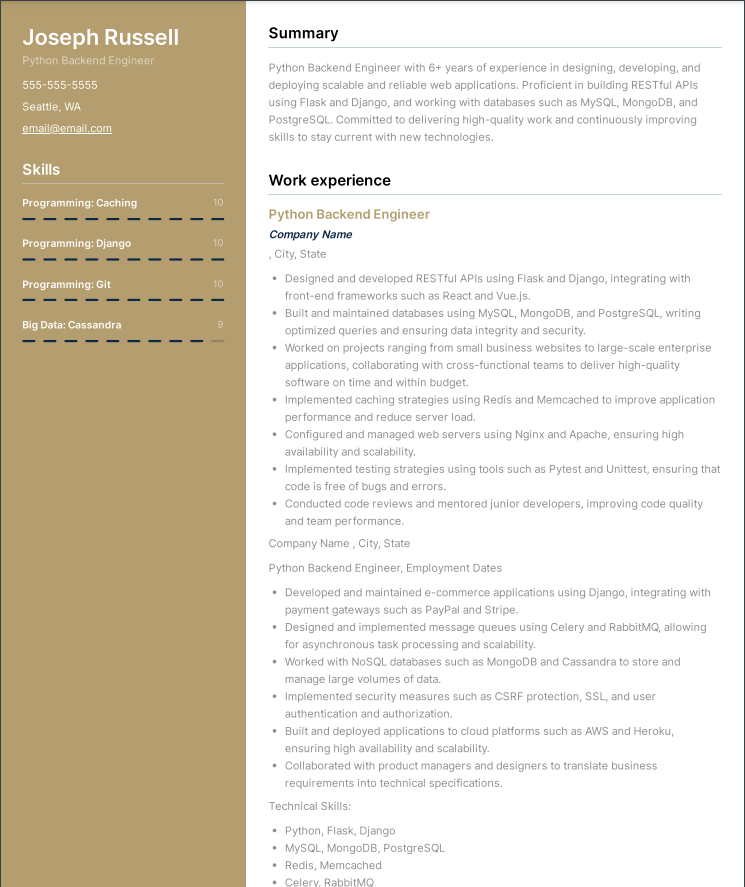
Django Python Developer Resume Example
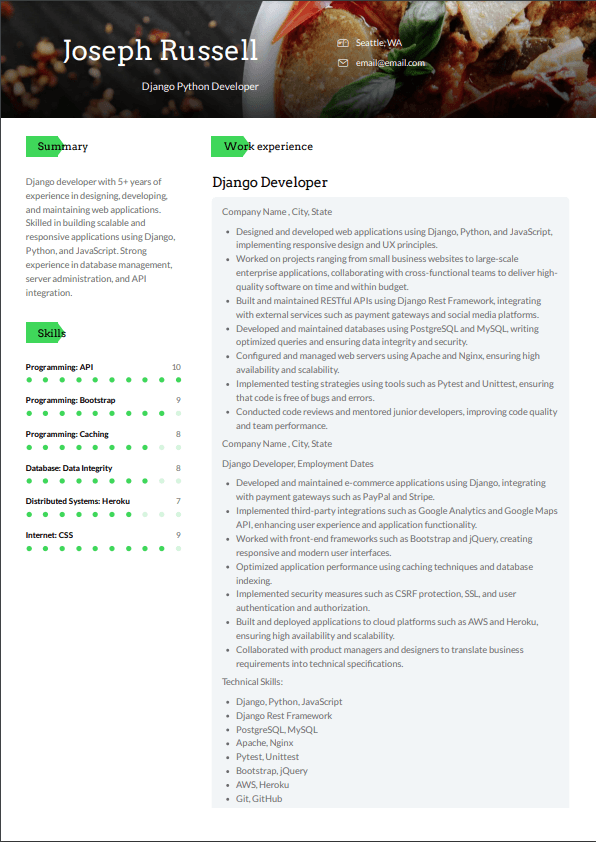
Senior Python Developer Resume Example
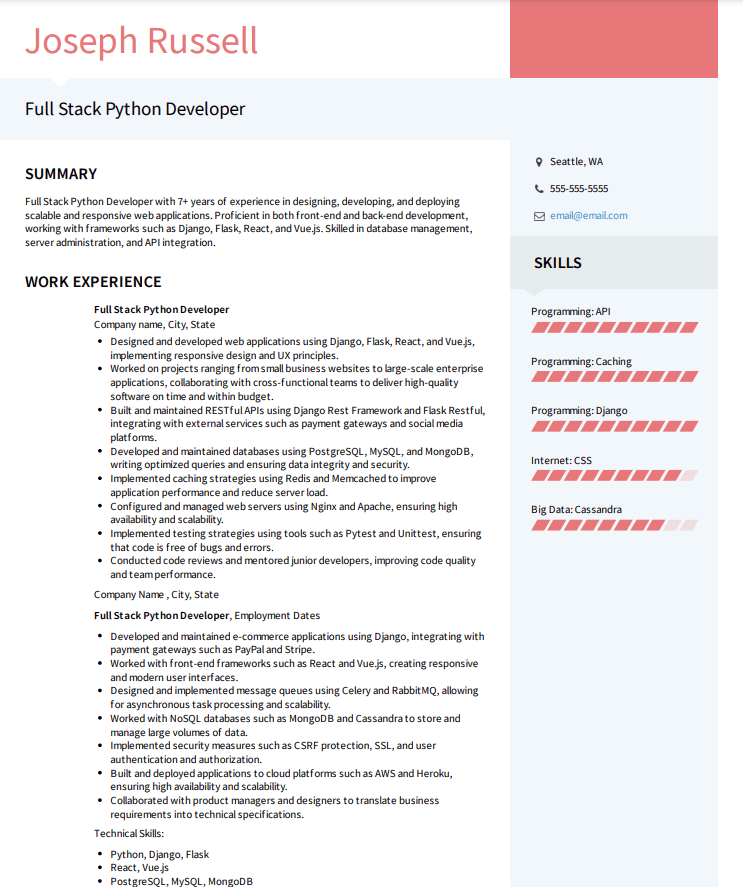
PySpark Python Developer (Data Engineer) Resume Example
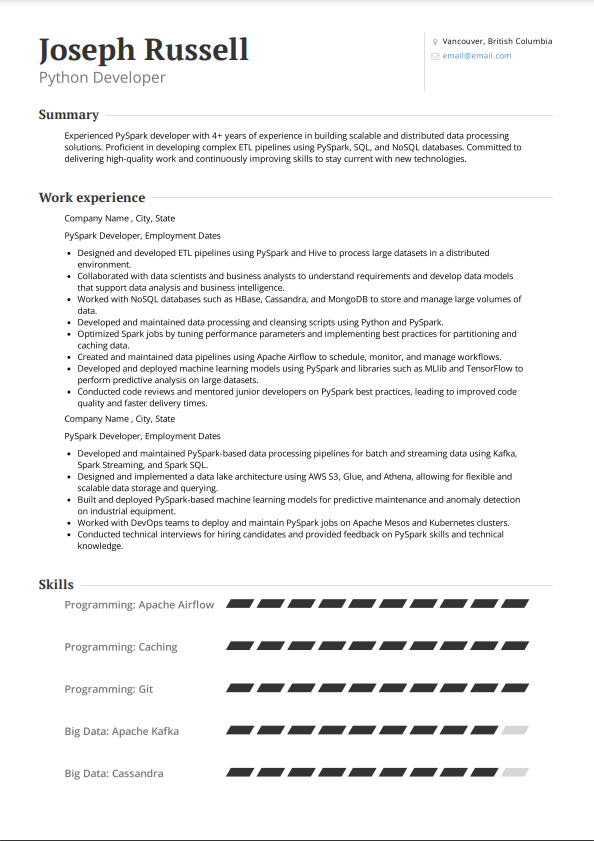
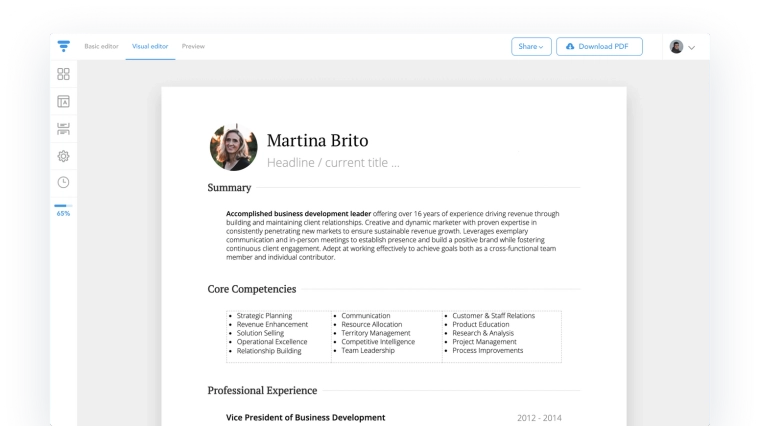
When you ask for a feedback on your Python resume, it isn’t uncommon to hear unhelpful advice like:
- Your resume is too long, no one would read it.
- List more Python projects on your resume.
- Remove “this” section.
The reality is that none of the advice is contextual to your resume, neither is it actionable. Instead you need to truly understand what type of Python developer job you are applying to and shape your resume for it.
To begin with, if you are applying for a very competitive Python role (e.g. a MAANG job), you’ll be competing with top talent. Your resume should look like one!
What Hiring Managers Expect from a Top Candidate’s Python Developer Resume?
Ideally, a hiring manager’s expectations are based on the following from a Python resume:
- Your Python programming skills - performant, maintainable, and testable Python code.
- Significant Python development experience beyond simple helloWorld.py type projects.
- Your expertise with frameworks they use - Django, Flask, Spark, etc.
- Maintainability of your code - they are concerned if you are going to write a module that’s only going to increase tech debt.
- Scalability of your code - if scalability is their concern, they want you to be able to write Python code that can scale their business product(s)/service(s).
- Testability of the Python code you write - if the company practice is to write >90% testable code, they would expect you to be able to write highly testable code.
- Ability to learn - this is important as Python developers are expected to learn and build at the same time. They expect to see this from your resume.
- A Python resume isn’t just expected to write code - but also be able to deploy and document well too.
- A talented Python developer would be able to display their thoughtfulness when it comes to architectural design patterns.
- If the job demands a full stack Python developer, a top resume would be expected to have a solid command of other front end, backend languages and expected to know your way around databases.
- Projects, especially open source projects that display your Python skills are highly appreciated.
Broadly speaking, most applicants would create Python Developer resumes for one of the following jobs:
- Python roles at top organizations like Google.
- Entry level Python roles.
- Mid-level Python roles.
- Senior Python roles.
For each of these jobs there are subtle differences in the way we create those Python Developer resumes. In our “how to write a Python Developer resume” section, we will discuss each of them.
How to Write a Python Developer Resume
To write a Python Developer resume that land interviews, do the following:
- Select the right Python Developer resume format - reverse chronological, functional or combination layout. Select the right one based on your relevant work experience.
- Add the most common sections that every hiring manager expects - header, summary/objective, work experience, skills, projects, and education.
- As a Python developer, you have a broad set of skills - read the job description to understand which ones are relevant to the job. Build your Python Developer resume around it.
- Use the STAR format while listing your Python and other programming work experience.
- Add your Github or portfolio page links in the header section.
- Your education section should be short if you have significant work experience, otherwise consider adding more relevant details.
- Keep your resume one page if your total experience is less than 15 years. It is acceptable to have a Python resume of two pages or more with more than 15 years of experience.
- Do a quick 10 second test to see if you can locate key information just by glancing before you finish writing your resume. If you are unable to find information consider adding/removing content, improve visual hierarchy or rearrange resume sections.
How to Write an Experienced Python Developer Resume
To write an experienced Python developer resume, follow these steps:
- Select a reverse chronological resume layout if total experience is less than 15 years. Else, select a functional or combination resume layout.
- Avoid adding entry level projects that reduce the overall impact of your resume. Be very picky about what type of Python projects you would like to list.
- Scan the job description and look at all major Python frameworks listed in it. If you have experience with them, list them in your skills section and show how you built Python apps/services using them in your work experience.
- Your Python work experience should display either of these at minimum: scale of work, quality of code, testability, maintainability, and your ability to mentor junior Python developers.
- If the job description asks for a specific skill (e.g. real time data handling capabilities for fintech) - customize your resume around it.
- Display your project management skills and the scale of projects managed (e.g. size, cost savings, etc) if the job asks for a Python developer with project management experience.
- Highlight your capabilities in understanding software architectures that scale and achieve business values.
- Any senior Python developer is expected to also have top notch DevOps skills too.
- While writing your resume don’t add languages or skills that can’t be backed by either of your experience, certifications, or education.
How to Write a MAANG Python Resume
While writing a MAANG Python resume, you need to do the following:
- Make sure to go through each MAANG’s own criterias/principles e.g. Amazon has Amazon’s leadership principles. Ensure that your resume reflects that you exceed these requirements.
- Avoid using the same resume for all MAANG companies. You should be creating a specific resume for each company.
- Highlight your resume around very specific topics that the job demands. For example, if the job is focused on data engineering, ensure that your resume exceeds what they expect from a Python Data Engineer.
- If you have an impressive Github profile, link out to it from your Python resume’s header.
- But if you have a few impressive open source projects, create a separate section for your Python projects.
- While writing your Python experience you should highlight the impact and complexity of your Python work. E.g. Created a 3 tier deep learning architecture to improve spare parts recognition from 96% to 99.7% accuracy.
- Write 4-5 versions of your Python summary make sure it shows your total years of experience in Python (and other demanded skills), your Python expertise, and your achievements.
- If you have an academic background and have published research papers - you can create a specific section for published research and link out to them.
But what if you are an entry-level Python developer with no experience trying to write a resume?
If you are in the early stages of your career, the good news is that lack of experience can now be compensated with internships, personal projects, or open source contributions.
Doing so highlights that you are an extremely self-driven Python developer and are a very passionate Pythonista.
How to Write an Entry Level Python Developer Resume
- First of all, select a functional or a combination layout for your Python resume.
- Next, add an objective instead of a summary to explain why you are a great fit for a Python job.
- While you lack Python experience, replace it with either Python or any other relevant tech internship or simply add Python projects in its place.
- Be selective while adding other tech stack to your Python resume. Consider subsetting your most visible skills to those that are present in the job description.
- List your Github, open source Python projects, and any other portfolio links in your resume header.
- While listing any project or a Python internship experience, display thoughtfulness in your programming decisions. Display the scale and impact of your projects.
- Keep your resume’s length to one page.
Metaphorically, you just did:
pip install VisualCV
Now, let’s import this Python resume and make it even better.
from VisualCV import better_resume
While you are at it, why not try importing your existing resume and give it a makeover with VisualCV?
It is as simple as: updated_resume = VisualCV.doc_read(‘oldResume.docx’) Or updated_resume = VisualCV.pdf_read(‘oldResume.pdf’)
We will now show you how to write individual sections of your Python resume with examples.
Optimize Your Python Resume’s Header
The key to a perfect resume header is:
- Add your full name.
- Avoid listing your full street address. Just listing city and state should be sufficient.
- Add your contact information - your phone number and a professional email (no cooldude2020@gmail.com).
- Add a link to your Github/Gitlab and any other portfolio (e.g. a website or a Python blog or Stackoverflow profile).
- List your current (or prospective job title) in the header. It helps a hiring manager understand what you currently do or aspire to do.
List them and you have got yourself a nearly perfect resume header for a Python developer.
Bad Example - Django Python Developer Resume Header
Mark, 3904 Millbrook Road, Naperville, IL 60540, 6307539566, coolmark420@gmail.com
Let’s break it down by why it is the wrong way to write a Python resume header.
First of all, it doesn't even list the full name of the Python candidate.
Second, there’s no need to add a full street address to your resume. No employer needs that information, and it only detracts them from discovering meaningful information about you.
Third, make it easier for hiring managers to give you a callback if they like your resume. Best if you make the phone numbers easier to read by following the format xxx-xxx-xxxx.
Fourth, the email “coolmark420@gmail.com” isn’t professional either. When you are competing against hundreds of other Python candidates, you have to make sure you don’t leave any stone unturned.
Good Example - Django Python Developer Resume Header
Mark McLedon, Senior Python Developer, Naperville, IL, 630-753-9566, mark.mcledon12@gmail.com, github.com/mld_python, https://stackoverflow.com/users/2121002/ml
What makes this Python developer resume example better?
- Has everything a hiring manager would look for.
- The Github link allows the hiring manager to see Python code quality and explore projects that the candidate has done.
- The stackoverflow profile shows the depth of the candidate's technical capabilities.
If you don’t have a stackoverflow profile, you can add your Python blog or something like dev.to profiles too.
Note - We would suggest you avoid listing your stackoverflow profile if you are below the top 40% overall under the Python tag.
Should You Write an Objective or a Summary on Your Python Resume?
If you have no Python specific experience, go for an objective to explain why you are applying for the job or justify a transition to a Python role. Else, write a Python specific resume summary instead.
If python_experience == 0: print(‘Write an objective’) else: print(‘Write a summary’)
Python Resume Objective Examples
Junior Python Developer Resume Objective Example
A Junior Python Developer seeking to leverage Python programming to contribute to the development of data heavy fintech applications. Passionate about Apache Spark and building highly performant data applications.
Example of Python Resume Objective for Career Transition
Aspiring Python developer passionate about leveraging 5 years of building enterprise applications for banking, travel, and hospitality industries. Core expertise: clean architectures, programming leadership, full stack development, and TDD.
Python Resume Summary Examples
Full Stack Python Developer Resume Summary Example
Full Stack Python Developer with over 4 years of experience designing and implementing scalable software solutions for diverse industries. Skilled in full-stack development, with expertise in Flask, Django and front-end technologies such as HTML, CSS, and JavaScript.
Senior Python Developer Resume Summary Example
Senior Python Developer with over 10 years of experience developing highly scalable, real-time web apps using Flask. Proficient in data analysis and machine learning using Python libraries such as NumPy, Pandas, and Scikit-learn.
Python Engineer Resume Summary Example
Python Engineer with a strong background in designing and deploying scalable network solutions using Python programming and related tools such as Ansible and Terraform. Passionate about leveraging Python to automate network processes and optimize network performance.
Big Data Python Developer Resume
Python Developer with extensive experience in designing and implementing scalable big data solutions. Skilled in utilizing the full range of Python data science tools, including Pandas, NumPy, and SciPy, and experienced in working with Big Data frameworks such as Apache Spark, Hadoop, and Kafka.
How to List Your Python Experience on Resume?
The best way to list your Python work experience on your resume and win a job is by:
- Following the STAR format and list down all Python projects (prioritized by impactfulness) under each employer.
- While listing your Python work experience, make sure to add other languages that you used (e.g. Go) and cloud technologies (e.g. AWS streaming service).
- Highlight the important details in your Python experience - e.g. concurrency, latency, requests per second, etc handled through your Python code.
- Make sure to list any architectural design work you did and the impact it made.
- If you have DevOps experience, make sure to highlight it in your experience too.
Below are a few Python developer resume examples to show you how to write the perfect experience section.
Senior Python Developer Resume Work History Example
Senior Python Developer
- Developed and optimized data structures and algorithms for high-performance data processing tasks.
- Implemented unit testing and continuous integration pipelines to enhance code reliability and deployment speed.
- Spearheaded the migration of legacy systems to cloud-based solutions using Google Cloud.
- Enhanced database management processes, improving query performance and data retrieval times.
- Maintained technical documentation for all major projects to ensure clarity and knowledge sharing across cross-functional teams.
Python Developer (Data Engineer) Resume Example
Python Developer (Data Engineer)
- Designed and maintained scalable data processing pipelines using PySpark and Apache Kafka.
- Collaborated with the data science team to develop and deploy machine learning models in a production environment.
- Ensured data accuracy and integrity across all data workflows by implementing robust data validation procedures.
- Created scripts for data extraction and transformation, leveraging SQL and NoSQL databases.
- Conducted code reviews to ensure adherence to Python best practices and optimize code quality.
Python Developer Experience Section
Python Developer
- Developed and maintained web applications with a focus on scalability and performance using Python frameworks like Django and Flask.
- Collaborated with cross-functional teams to implement features that improved user experience and adhered to user interface guidelines.
- Conducted code reviews and enforced Python best practices to ensure high code quality across projects.
- Utilized version control systems like Git for seamless collaboration and deployment
Python Developer Experience Section
Python Developer
- Designed and deployed a Python-based web application that streamlined client operations, leading to a 20% increase in efficiency.
- Implemented a robust continuous integration pipeline that reduced deployment time and minimized production issues.
- Enhanced the system’s database management by integrating SQL and NoSQL databases, optimizing queries for faster data retrieval.
- Collaborated on web development projects using modern technologies and frameworks, ensuring responsive and dynamic user interfaces.
- Led efforts in maintaining technical documentation to support ongoing development and knowledge sharing.
Junior Python Developer Experience Section
Junior Python Developer
- Developed several Python scripts to automate routine tasks, improving operational efficiency by 25%.
- Contributed to web development by creating dynamic user interfaces and backend services, adhering to software development life cycle principles.
- Participated in agile teams, implementing features and bug fixes in a Python-based web application.
- Assisted in data extraction and transformation tasks, working closely with data analysts to support business intelligence initiatives.
- Documented processes and contributed to maintaining technical documentation for future reference
Certified Python Developer Resume Example
Certified Python Developer
- Built and maintained responsive web applications using Flask and Django frameworks.
- Optimized existing Python codebase for performance, reducing load times by 30%.
- Developed interactive user interface guidelines in collaboration with the UX team, ensuring a seamless user experience.
- Integrated third-party APIs and services to expand application functionality and improve user engagement.
- Utilized version control systems like Git for efficient code management and collaboration.
Junior Python Developer Resume Example
Junior Python Developer
- Developed Python scripts for automating routine tasks, increasing efficiency by 40%.
- Participated in designing and implementing a Python-based web application for client management.
- Gained hands-on experience with AWS S3 for secure and scalable data storage solutions.
- Contributed to the development of new features following agile methodologies and participating in daily stand-ups.
- Assisted in optimizing database queries, enhancing system performance and user experience.
Software Engineer Resume Example
Software Engineer
- Collaborated on the design and development of web development projects, focusing on both front-end and back-end solutions.
- Implemented robust coding skills in Python, ensuring code maintainability and scalability.
- Worked with third-party services to integrate new functionalities into existing platforms.
- Played a key role in enhancing test coverage to ensure software reliability and stability.
- Developed and deployed applications adhering to the software development life cycle, ensuring timely delivery and quality standards.
Software Engineer Experience Section
Software Engineer
- Spearheaded the development of web applications using Python frameworks and integrated with third-party services for enhanced functionality.
- Improved system performance by optimizing database queries and ensuring efficient data handling.
- Worked on improving the test coverage of legacy systems, ensuring compliance with company standards for software reliability.
- Collaborated with cross-functional teams to design and implement new features that aligned with business goals.
- Maintained high code quality through rigorous code reviews and adherence to best practices.
Senior Python Developer Resume Work History Example
Python Developer
- Designed and developed internal web applications and APIs using Flask and Django.
- Conducted performance testing and optimization of application code, resulting in improved application speed and stability.
- Managed and maintained the company's server infrastructure, ensuring 99.97 SLA uptime and security.
- Migrated over 5 enterprise web applications to a modern Django based backend without any downtime.
Experience Section from a Senior Python Developer Resume
Senior Python Developer PowerTrain Inc.
- Designed and developed a new PowerTrain Explorer for the PT Logistics tool using Python and JavaScript, making it more modern and user friendly.
- Implemented Python test suite to increase test coverage to 95%.
- Developed application level design and technical specifications for our end-user application to handle 350+ API requests per second.
- Implemented program and system walk-throughs with Product Managers and Analysts for new projects.
- Unified development environment companywide using Docker containers, reducing the time it took to train new developers by 2x.
Pyspark Python Developer Resume Example (experience)
Pyspark Python Developer
- Designed and developed ETL pipelines using PySpark and Hive to process large geospatial datasets in a distributed environment.
- Develop data models that support terrain data analysis for urban mobility teams.
- Worked with NoSQL databases such as HBase, Cassandra, and MongoDB to store and manage 5 Petabytes of data.
- Developed and maintained data processing and cleansing scripts using Python and PySpark.
- Optimized Spark jobs by tuning performance parameters and implementing best practices for partitioning and caching data.
- Created and maintained data pipelines using Apache Airflow to schedule, monitor, and manage workflows.
- Conducted code reviews and mentored junior developers on big data best practices, leading to improved code quality and 5 times faster delivery times.
How to List Python on Resume?
You can list Python on the following parts of your resume:
- Summary or objective section.
- Your work experience section. List what you built using Python and the business impact it made.
- Your skills section - list Python as a programming language, but also list specific frameworks for server, frontend, testing, etc that you use.
- Your projects section - list Python projects to show what you built.
- Education section - if you leveraged Python extensively at university/college and you are not a very experienced Pythonista, we recommend that you list Python in your education section too.
So, what’s pending on your Python resume? Let’s do:
pip list
We don’t see the skills and education section in our output. Let’s dive into them.
Top Python Resume Skills for 2024
- Python programming
- Django
- Flask
- Data structures
- API
- Pytest
- Javascript
- unittest
- NumPy
- Pandas
- Database
- Architecture
- Pair programming
- Code review
- DevOps
- Git
- Machine learning
- AWS
- Azure
- TDD
- Scrum
- Agile
Other Python Skills for Your Resume in 2024
- PySpark
- TensorFlow
- Spark SQL
- Tornado
- Spark Streaming
- HTML
- Hadoop
- Hive
- HBase
- Cassandra
- MongoDB
- Apache Kafka
- Apache Airflow
- MLlib
- NumPy
- SciPy
- Pandas
- SQL
- NoSQL
- AWS S3
- Glue
- Athena
- GitHub
- BDD
- GitLab
- Docker
- Kubernetes
- Apache Mesos
- Python scripts
- Python libraries
- Python frameworks
- Software development
- Data analysis
- Machine learning model
- Machine learning projects
- Version control systems
- Continuous integration
- Unit testing
- Database management
- Web development
- Scalable data processing pipeline
- Optimized database queries
- Code reviews
- Test coverage
You can add more relevant Python development skills based on the job description as well. Listing relevant skills is extremely important and helps a hiring manager see that you are the right person. It can show them you know the required programming languages, have the coding skills, data processing efficiency, etc.
Finally, how do you list your education on a Python resume?
Let’s take a look.
How to List Your Education on a Python Resume
Unless you are an entry-level Python applicant, the right way to list education on Python resume is: [Degree], [University/College name], Start year - End year
Adding more details while listing education on your Python resume would only increase your resume’s length or reduce the total available space for relevant information.
However, if you are someone with zero Python experience or an entry-level Python Developer, list education using this format instead.
Python Resume Education Format Example for No Experience or Entry-Level Python Developers
[Degree], [University/College name], Start year - End year
- One line description of what Python projects/relevant coursework did
- One line description of what Python projects/relevant coursework did
- One line description of what Python projects/relevant coursework did
Just make sure you don’t make it too long.
And that’s all it takes to write a Python resume that can land you any job you want!
- Python Developer Resume Example (Backend Engineer)
- Django Python Developer Resume Example
- Senior Python Developer Resume Example
- PySpark Python Developer (Data Engineer) Resume Example
- What Hiring Managers Expect from a Top Candidate’s Python Developer Resume?
- How to Write a Python Developer Resume
- How to Write an Experienced Python Developer Resume
- How to Write a MAANG Python Resume
- How to Write an Entry Level Python Developer Resume
- Optimize Your Python Resume’s Header
- Should You Write an Objective or a Summary on Your Python Resume?
- Python Resume Objective Examples
- Python Resume Summary Examples
- How to List Your Python Experience on Resume?
- Senior Python Developer Resume Work History Example
- Python Developer (Data Engineer) Resume Example
- Python Developer Experience Section
- Python Developer Experience Section
- Junior Python Developer Experience Section
- Certified Python Developer Resume Example
- Junior Python Developer Resume Example
- Software Engineer Resume Example
- Software Engineer Experience Section
- Senior Python Developer Resume Work History Example
- Experience Section from a Senior Python Developer Resume
- Pyspark Python Developer Resume Example (experience)
- How to List Python on Resume?
- Top Python Resume Skills for 2024
- Other Python Skills for Your Resume in 2024
- How to List Your Education on a Python Resume

Written By
Ben Temple
Community Success Manager & CV Writing Expert
Ben is a writer, customer success manager and CV writing expert with over 5 years of experience helping job-seekers create their best careers. He believes in the importance of a great resume summary and the power of coffee.

If you want to land a job as a scrum master in an Agile development environment, it's important to write a great scrum master resume.
January 10, 2023
Read Post

Community Success Manager & CV Writing Expert
![How to Write an IT Project Manager Resume [With Examples]](/static/abeee684e86ab97c39ec9f13192559c1/61ca5/IT_Project_Manager_Hero-min.jpg)
Do you thrive on planning and executing major projects, all while applying your in-depth IT knowledge? You might just be an IT project manager in the making! Find out how to write an IT project manager resume here.
December 27, 2022
Read Post

VP Marketing & Resume Expert
![How to Write a Cloud Services Developer Resume [With Examples]](/static/25f5eb4143f5ae01c8eec9f51f2cac38/61ca5/Cloud_Services_Dev_Hero-min.jpg)
Learn how to create the best cloud services resume (no matter what your experience level is) and land that dream cloud services job!
December 28, 2022
Read Post

VP Marketing & Resume Expert
Copyright ©2025 Workstory Inc.